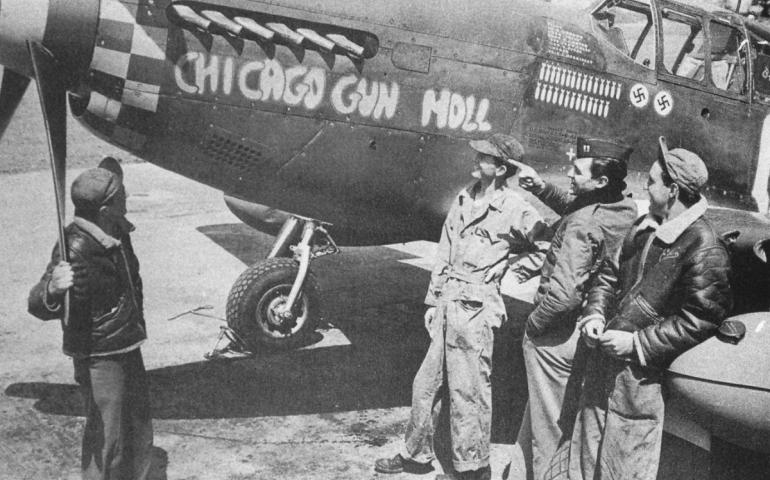
P-51 B-5-NA, Serial No. 43-6556, Nickname: Chicago Gunn Moll, 8th Air Force, 357th Fighter Group, 362nd Squadron
Pilot: Capt. Robert D. Brown
On May 27, 1944, Ludwigshafen was one of the targets of a large-scale attack on important industrial areas in Central Germany. The 8th U.S. Air Force sent 930 heavy bombers over Fortress Europe, escorted by 710 escort fighters of the types P-38, P-47 and P-51. Ludwigshafen was supposed to be attacked as early as April 1, 1944, but while the Flying Fortresses were already turning back over France, Liberators of the 44th and 392nd Bomb Group mistakenly bombed Schaffhausen, while a third group chose Strasbourg as an alternative target. Led by Major Irwin H. Dregne, the 357th Fighter Group Mustang took off from Leiston to accompany 150 Ist Air Division Fortresses to Ludwigshafen. Leiston, located near Yoxford in East Anglia, was known during the war only under the code name "Army Air Force Station F-373". The pilots of this fighter group were also given the nickname "The Yoxford Boys". In 313 missions, they destroyed 609 airborne enemy aircraft and 106 on the ground, but also lost 128 of their own fighters. North of Strasbourg, shortly after the 11.30 am encounter with the bombers, there was a wild scramble with about sixty Messerschmitt Bf 109s and Focke Wulf Fw 190s, which also managed to shoot some B-17s out of the lead formation. Fourteen Germans fell victim to the “Yoxford Boys”’s deadly Browning-Bord-MGs. Lieutenant Cyril Conklin and Thomas Harris, each having had two aerial victories, were shot down during aerial combat and spent the rest of the war in captivity, while Lieutenant Dean Post fell on this 357th fighter group’s 65th mission. Captain Robert D. Brown, an old hand who flew with the group from the beginning, was able to book his third air victory, but loose debris of the shot down aircraft damaged the Merlin engine, so that a safe return was unthinkable. The 23-year-old captain from Chicago tried to save his battered Mustang in Switzerland. This fighter had rolled out of the halls of the North American factories in Inglewood, California, on October 22nd, 1943. After the transcontinental flight, it landed in Buffalo two days later, where the P-51B-5-NA got additional equipment. Dismantled and crated in Newark on December 14th, 1943, it arrived in Blackpool, England in January, 1944, where it was reassembled and handed over to the 357th Fighter Group, 362nd Squadron, with the registration number G4-B. Their pilot, Robert D. Brown, christened her "Chicago Gun Moll”. Brown had some trouble finding safe Switzerland. Only a few kilometers after reaching the border, the Packard-Merlin V-1650-3 engine stopped working and the pilot had to bail out. At 12.10 pm, the "Chicago Gun Moll" drilled into the ground just a few meters from the restaurant "Berghaus", where the Stadler innkeeper family was eating lunch. The force of the impact on the vineyard near Lütisburg uprooted three trees, and a fire broke out in the building, but it was quickly extinguished. Only a few ruins remained of the plane, a much sought-after item for schoolboys. Robert D. Brown broke his leg when landing on a fir tree. But it was a blessing in disguise: there had been a high-voltage power line only a few meters away from the tree! The pilot was taken on a stretcher to the doctor in Bütschwil, who admitted him to the hospital in Wattwil. Since Brown had been under medical treatment for a long time as a result of his broken leg, he did not go to Davos to join the other American officers, but remained interned in Bütschwil with Poles and Africans until his return in spring, 1945. From November 1945 to February 1946 Brown was Squadron Commander of the 357th Fighter Group, which had been stationed in Germany in the meantime. Unfortunately, he died in America shortly thereafter.